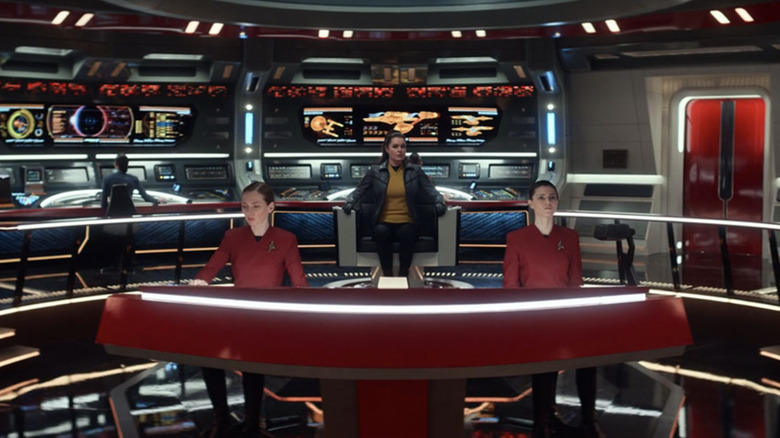How AR Video Walls Have Completely Changed Filming A Star Trek Show [Comic-Con]
Throughout the entirety of "Star Trek," the space-set series has always been known for its groundbreaking ways of incorporating advancements in technology to help give the show its iconic "futuristic" look. As the canon of "Star Trek" has expanded, so too has the timelines of its stories. "Star Trek: Discovery" jumped thousands of years between seasons, which meant the production and design teams had to create the look of a new landscape shaped by hundreds of years of future tech. In the days before CGI and digital image manipulation, this led to design choices like square shaped helmets shown in the original run of "Star Trek." Now with the assistance of tools like augmented reality, the way "Star Trek" is filmed has completely changed.
The definition of augmented reality has changed in line with technological evolution, but as it currently stands, AR is the name for the type of technology utilized in the spectrum of mixed reality that allows layering virtual objects onto real life. Typically, these virtual objects are shown through the screen of mobile devices like phones and tablets. Perhaps the most commonly known example of AR is the mobile game "Pokémon GO," which allows users to see Pokémon just hanging around their house by looking through the screen of their phone. For a show like "Star Trek," it means they can build massive screens to project landscapes, objects, and even movement onto the screen that are able to respond to camera focus. Essentially, they can build entire sets or worlds with the assistance of ARWall technology.
A never before seen size to the show
During the "Star Trek" Universe panel at San Diego Comic-Con, some of the cast and creatives talked about what it's like to utilize this new tech. "Its slowly what's beginning to replace green screen technology in our industry," said Anson Mount, who stars on "Star Trek: Strange New Worlds." Rather than having the actors perform in front of a screen where the image is included afterward, the CG environment is crafted before the production starts shooting. "The computer program that controls it also sees through the camera," Mount said. "So when the camera moves, the background can move to make it look as far or as close as you want it to look."
Not only does this help with the appearance of realism (we've all seen an old movie where the background moves in the window of a car), as Mount said, "It just gives a size to the show we've never had before." Early seasons and films of "Star Trek" often shot in deserts to give the appearance of planets, but with the ARWalls, there's no limit to the creativity. It's also a great treat for the actors because, as Mount said, "It allows us to be in the world and not have to be building it while we're acting." Writer and executive producer Alex Kurtzman echoed the sentiments, noting that the use of ARWalls also allowed them to shoot on much wider camera lenses than previously used on "Star Trek" shows, because there was no need to "hide" the set or practical location limitations. Thanks to ARWall, "Star Trek" allows the cast and crew to enter, well, a strange new world of their own.

